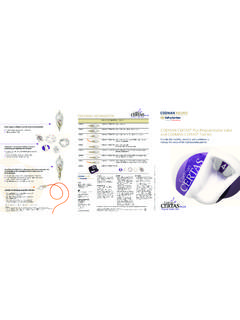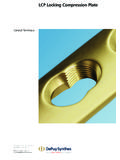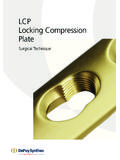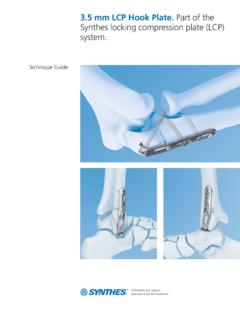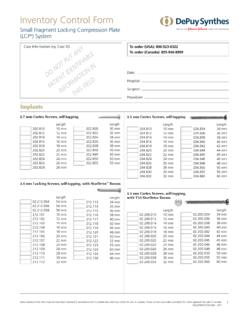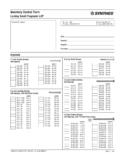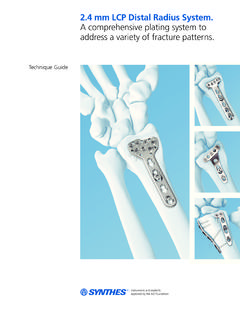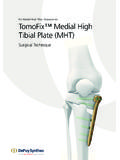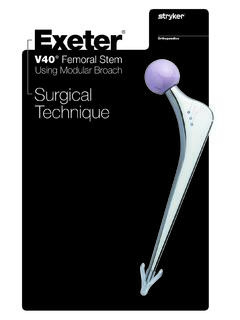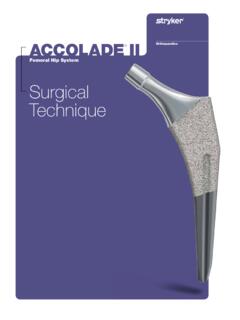Transcription of SUMMIT TAPERED HIP SYSTEM
1 SUMMIT TAPERED HIP SYSTEMSURGICAL TECHNIQUE & DESIGN RATIONALEPROVEN FIXATIONF ixation is the foundation of long-term clinical success. A biocompatible titanium alloy stem, combined with POROCOAT Porous Coating and underlying radial ZTT macro texture, creates a surface that is designed for initial stability, and biologic fixation to bone. DUOFIX Stems combine POROCOAT Porous Coating, which allows for biologic fixation to bone, with the addition of a 35 micron layer of hydroxyapatite (HA) weeks8 weeks12 weeks2 DePuy Synthes Companies SUMMIT T apered Hip SYSTEM Design Rationale & Surgical TechniqueDUOFIX HA Coating 35 micron non-occluding plasma spray deposited HA coatingClinical Results 1 of 96 revised (due to fall)
2 In a 5-year follow-up study2 Grit Blasted Distal Body Provides roughened surface engineered for supplemental stabilityPOROCOAT Porous CoatingPOROCOAT Porous Coating allows biological fixation to bone without the use of bone With more than 30 years of clinical heritage, our proprietary POROCOAT Porous Coating is composed of commercially pure titanium sintered metal Rationale & Surgical Technique SUMMIT T apered Hip SYSTEM DePuy Synthes Companies 3 Radial ZTT steps ZTT steps designed to eliminate hoop stress by directing radial force into compression. Provides lower risk of intra-operative fracture4**See graph on page 5 for comparison to leading competitorsADVANCED PERFORMANCEHoop stresses may increase risk of intra-operative fracture4 Radial ZTT is designed to convert hoop stresses to compression loads which may potentially reduce the risk of intraoperative Year Intra-operative Fracture Head 5 VerSys FM Taper 6.
3 7 Synergy 8 Omnifit HA 9 SUMMIT 3 Design Rationale & Surgical Technique SUMMIT T apered Hip SYSTEM DePuy Synthes Companies 5 Direct Lateralization Enables femoral offset restoration without affecting leg length Ability to lateralize by 6mm 8mm to manage soft tissue laxity depending on stem size Offset range 30mm 50mm depending on stem sizeADVANCED BIOMECHANICS High OffsetStandard OffsetSUMMIT Dual Offset options help surgeons more effectively manage soft tissue laxity when compared to systems with only one offset DePuy Synthes Companies SUMMIT T apered Hip SYSTEM Design Rationale & Surgical Technique149 Neck Geometry Designed for a larger ROM to decrease the risk of dislocation due to secondary prosthetic impingement Provides range of motion up to 149 degrees when coupled with the PINNACLE Acetabular Cup System10 Polished Neck Decreases risk of wear debris generation.
4 Secondary to prosthetic impingementDesign Rationale & Surgical Technique SUMMIT T apered Hip SYSTEM DePuy Synthes Companies 7 ADVANCED INSTRUMENTATIONC urvedStraightStraight-longDual-offset8 DePuy Synthes Companies SUMMIT T apered Hip SYSTEM Design Rationale & Surgical TechniqueThreaded impactorStraight modular impactorCurved modular impactorOffset modular impactorBullet-tip modular impactorCompatible with the SUMMIT , CORAIL and TRI-LOCK Bone Preservation Stem Systems, the TSS Core kits feature instrumentation to facilitate the femoral preparation for anterolateral, posterior or anterior approaches.
5 To further enhance OR flexibility, the TSS Core kits include two sets of trial heads, up to size 40mm, and can accommodate two different TSS broach CORE KITSD esign Rationale & Surgical Technique SUMMIT T apered Hip SYSTEM DePuy Synthes Companies 9 Figure 2: Cup Sizing and PositioningDetermination of Leg Length DiscrepancyPerform clinical and radiograph analysis to determine leg length management (Figure 1).Figure 1: Leg Length ManagementPRE-OPERATIVE PLANNINGA cetabular Cup Sizing and PositioningUse A/P radiograph to determine acetabular component position. Use the PINNACLE Acetabular Cup SYSTEM template overlays to determine the correct implant size (Figure 2).
6 Optimizing the position and bone contact are the main objectives in cementless acetabular the center of rotation of bearing surface on A/P vertical distance between the planned center of rotation of the acetabular component and the center of rotation of femoral head constitutes the distance the leg length will be : The targeted shell abduction (as measured on radiographs) should be 40 45 degrees taking into account each individual patient's local soft tissue and anatomic targeted shell anteversion (as measured on radiographs) should be 15 20 degrees taking into account each individual patient's local soft tissue and anatomic DePuy Synthes Companies SUMMIT T apered Hip SYSTEM Design Rationale & Surgical TechniqueFemoral Stem SelectionSelect the template that fits the proximal femur and equalizes the leg lengths.
7 The femoral template should be in-line with the long axis of femur. Mark the neck resection line at the point where the selected stem provides the desired amount of leg the chosen stem size also fits into the lateral plane and check for three point fixation (Figure 3).Figure 3: Three Point FixationDesign Rationale & Surgical Technique SUMMIT T apered Hip SYSTEM DePuy Synthes Companies 11 Figure 4: Neck OsteotomyFEMORAL NECK OSTEOTOMYA lign the neck resection guide with the long axis of the femur (Figure 4).Determine the resection level by aligning the top of the guide with the tip of the greater trochanter or measuring the pre-operatively determined distance above the lesser the resection line using electrocautery or methylene blue.
8 *Resect the femoral head.* Tip: Make a conservative neck resection initially and use the calcar planer to DePuy Synthes Companies SUMMIT T apered Hip SYSTEM Design Rationale & Surgical TechniqueFigure 6: Box OsteotomeOption 1 Medullary Canal AccessPlace the IM initiator at the posterior margin of the neck resection laterally near the piriformis the IM initiator until sufficient circumferential clearance for the box osteotome and canal probe is achieved (Figure 5).FEMORAL CANAL INITIATIONO ption 2 Box OsteotomeUse the box osteotome to enter the femoral canal at the junction of the femoral neck and greater trochanter (Figure 6).
9 If needed the box osteotome may be used to clear bone Rationale & Surgical Technique SUMMIT T apered Hip SYSTEM DePuy Synthes Companies 13 Figure 5: Medullary Canal AccessCanal ProbingUtilize the TAPERED canal probe to establish a direct pathway to the medullary canal. Advance the probe so that the superior margin of the cutting flutes meet the neck resection (Figure 7).Note: The probe should pass easily if proper alignment has been : Circumferential clearance of the probe is important to avoid reaming in the varus PREPARATIONF igure 8 Figure 7: Canal ProbingLateralizingAlignment Verification and Lateralizing The path established by the canal probe will dictate the route for trochanteric reaming, TAPERED reamers and : It is important to gain neutral alignment of the reaming (lateralizing) may be used to lateralize the proximal entry point for the TAPERED reamers; broaches aid in neutral stem alignment (Figure 8).
10 Correct AlignmentIncorrect Alignment11 DePuy Synthes Companies SUMMIT T apered Hip SYSTEM Design Rationale & Surgical TechniqueTapered ReamingSequential Ream starting 2 3 sizes below the pre-operatively templated size. Example: If the hip pre-operatively templated for a size 6 implant then TAPERED reaming would begin with the size 2 3 reamer and progress to the size 6 7 reamer. Each reamer has dual depth calibration lines for each of the two stem sizes, distally located for calcar referencing and proximally for greater trochanter referencing (Figure 9). TAPERED REAMINGF igure 9: TAPERED ReamingDesign Rationale & Surgical Technique SUMMIT T apered Hip SYSTEM DePuy Synthes Companies 15 FEMORAL BROACHINGF igure 10: Femoral BroachingStraightStraight-longCurvedDual -offsetBroaching the FemurWith the broach oriented laterally towards the greater trochanter, broach sequentially starting 2 3 sizes below the pre-operatively templated is one broach for every implant size.
